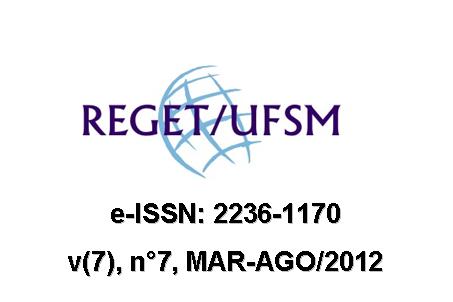RESISTÊNCIA GENÉTICA INDUZIDA EM PLANTAS CULTIVADAS
DOI:
https://doi.org/10.5902/223611705930Parole chiave:
Tolerância, Seletividade, Patógeno, Doença.Abstract
http://dx.doi.org/10.5902/223611705930
A indução de resistência envolve a ativação de mecanismos de defesa latentes existentes nas plantas em resposta ao tratamento com agentes bióticos ou abióticos. As plantas apresentam sistema de defesa induzível, com a finalidade de economizar energia. Desse modo, a resistência induzida em condições naturais representará custo apenas na presença do patógeno. Porém, plantas que investem seus recursos para se defenderem na ausência de patógenos arcarão com custos que refletirão na produtividade, uma vez que as alterações metabólicas que levam a resistência apresentam custo adaptativo associado, o qual pode pesar mais do que o benefício. O efeito negativo na produtividade ocorre principalmente onde indutores químicos são utilizados repetidas vezes ou em doses mais elevadas. Assim, em alguns casos podemos estar caminhando sobre uma estreita linha entre custo e benefício, onde a cura pode ser ruim tanto quanto a própria doença.
Downloads
Riferimenti bibliografici
AGRIOS, G. N. Plant pathology. 4 th ed. New York: Academic Press, 635 p. 2007.
BAKKER, P.A.H.M.; VAN PEER, R; SCHIPPERS, B. Suppression of soil borne plant pathogens by fluorescent pseudomonads: mechanisms and prospects. In: TEMPEL, A. (Ed.). Biotic interactions and soil-borne
diseases. Amsterdam, The Netherlands: Elsevier Scientific Publishers, p.217-30. 1991.
BLAICH, R; GRUNDHÖFER, H. Silicate incrusts induced by powdery
mildew in cell walls of diferent plant species. Zeitschift fur Pflanzenkrankheiten und Pflanzenschutz, v.105, p. 114-120. 1998.
CAMARGO, L. E. A.; BERGAMIN FILHO, A. Controle genético. In: BERGAMIN FILHO, A.; KIMATI, H.; AMORIM,L. (Eds). Manual de fitopatologia: princípios e conceitos, 3 ed. São Paulo, Agronômica Ceres, p. 729-758.1995.
CAO, H.; XIN, L.; DONG, X. Generation of broad-spectrum disease resistance by overexpression of an essential regulatory gene in systemic acquired resistance. Proc. Nat. Acad. Science, v. 95, p. 6531-6536.1998.
CARVALHO, N.L.; BARCELLOS, A.L. Adoção do manejo integrado de pragas baseado na percepção e educação ambiental .Revista Eletrônica em Gestão, Educação e Tecnologia Ambiental -REGET/UFSM v(5), n°5, p. 749 - 766, 2012.
CAVALCANTI, L.S.; PIERO, R.M.; CIA, P.; PASCHOALATI, S.F.; RESENDE, M.L.V.; ROMEIRO, R.S. Indução de resistência a patógenos e insetos. Piracicaba: FEALQ. 263 p. 2005.
CONRATH, U.; PIETERSE, C.M.J., Mauch-Mani, B. Priming in plant-pathogen interactions. Trends Plant Sci. 7:210-6. 2002.
COELHO, R. S. B.; Resistência Genética a Doenças na Cultura do Inhame (Dioscorea spp.); Empresa Pernambucana de Pesquisa Agropecuária-IPA, Av. General San Martin, 1371, Bongi, Recife – PE. 2003.
CHÉRIF, M.; MENZIES, J.G.; BENHAMOU, N.; BÉLANGER, R.R. Studies of silicon distribution in wounded and Pythium ultimum infected cucumber plants. Physiological and Molecular Plant Pathology, v.41, p. 371-385. 1992.
DARWIN, C. On the Origin of Species by Means of Natural Selection, or The Preservation of Favoured Races in the Struggle for Life. 1859.
DATNOFF, L.E., DEREN, C.W.; SNYDER, G.H. Silicon fertilization for disease management of rice in Florida. Crop Protection, v.16, p. 525-531. 1997.
DE BOER, M.; VAN DER SLUIS, I.; VAN LOON, L.C., BAKKER, P.A.H.M. Combining fluorescent Pseudomonas spp. strains to enhance suppression of fusarium wilt of radish. Eur. J. Plant Pathol. 105:201-10. 1999.
KLOEPPER, J.W.; LEONG, J.; TEINTZE, M.; SCHROTH, M.N. Enhanced plant growth by siderophores produced by plant growthpromoting rhizobacteria. Nature 286:885-6. 1980.
LEEMAN, M.; VAN PELT, J.A.; HENDRICKX, M.J.; SCHEFFER, R.J.; BAKKER, P.A.H.M., AND SCHIPPERS, B. Biocontrol of fusarium wilt of radish in commercial greenhouse trials by seed treatment with Pseudomonas fluorescens WCS374. Phytopathology 85:1301-5.LUCAS, A. J. Plant pathology and plant pathogens, 3 th ed. London, Blackwell Science Ltd., 274 p. 1998.
MAUAD, M.; GRASSI FILHO, H.; CRUSCIOL, C.A.C.; CORRÊA, J.C. Teores de silício no solo e na planta de arroz de terras altas com diferentes doses de adubação silicatada e nitrogenada. Revista Brasileira de Ciência do Solo, v.27, p. 867-873. 2003.
MENZIES, J.G.; EHRET, D.L.; GLASS, A.D.M.; HELMER, T.; KOCH, C.; SEYWERD, F. Effects of soluble silicon on the parasitic fitness of Sphaerotheca fuliginea on Cucumis sativus. Phytopathology, v.81, p. 84-88. 1991.
PIETERSE, C.M.J.; VAN WEES, S.C.M.; HOFFLAND, E.; VAN PELT, J.A., VAN LOON, L.C. Systemic resistance in Arabidopsis induced by biocontrol bacteria is independent of salicylic acid accumulation and pathogenesisrelated gene expression. Plant Cell 8:1225-37. 1998.
RAAIJMAKERS, J.M., WELLER, D.M.. Natural plant protection by 2,4-diacetylphloroglucinol-producing Pseudomonas spp. in take-all decline soils. Mol. Plant-Microbe Interact. 11:144-52. 1998.
REZENDE, J.A.M.; MARTINS, M.C. Doenças do mamoeiro. In: KIMATI, H., AMORIM, L.; REZENDE, J.A.M.; BERGAMIM FILHO, A.; CAMARGO, L.E.A. (Ed). Manual de Fitopatologia. Doença das plantas cultivadas. São Paulo: v. 2, p. 435-443. 2005.
RODRIGUES, F.A.; VALE, F.X.R.; KORNDÖRFER, G.H.; PRABHU, A.; DATNOFF, L.E.; OLIVEIRA, A.M.A.; ZAMBOLIM, L. Influence of silicon on sheath blight of rice in Brasil. Crop Protection, v.22, p. 23-29. 2002.
ROMPF, R.. An elicitor-induced cDNA from aerial (Dioscorea bulbiferaL.) encodes a pathogenesis-related type 4 protein. Plant Cell Reports, v. 18, p.601-608. 1999.
SCHIPPERS, B.; BAKKER, A.W.; BAKKER, P.A.H.M. Interactions of deleterious and beneficial rhizosphere micoorganisms and the effect of cropping practices. Annu. Rev. Phytopathol. 115:339-58. 1987.
STADNIK, M. Indução de resistência a oídios. In: CONGRESSO PAULISTA DE FITOPATOLOGIA, Campinas. Anais do Congresso Paulista de Fitopatologia, v. 23, p. 176-181. 2000.
STICHER, L.; MAUCH-MANI, B.; METRAUX, J. P. Systemic Acquired Resistance. Ann. Rev. Phytopathology, v.35, p. 235-270, 1997.
TON, J.; VAN PELT, J.A.; VAN LOON, L.C., PIETERSE, C.M.J. Differential effectiveness of salicylate-dependent and jasmonate/ethylenedependent induced resistance in Arabidopsis. Mol. Plant-Microbe Interact. 15:27-34. 2002.
TUZUN, S.; KUC, J. Plant immunization: an alternative to pesticides for control of plant diseases in the greenhouse and field. Technical Bulletin-Food and Fertilizer Technology Center, v.124, 11 p. 1991.
VAN LOON, L.C.; BAKKER, P.A.H.M. PIETERSE, C.M.J. Systemic resistance induced by rhizosphere bacteria. Annu. Rev. Phytopathol. 36:453-83. 1998.
VAN PEER, R., SCHIPPERS, B. Plant growth responses to bacterization and rhizosphere microbial development in hydroponic cultures. Can. J. Microbiol. 35:456-63. 1989.
VAN WEES, S.C.M.; PIETERSE, C.M.J.; TRIJSSENAAR, A.; VAN 'T WESTENDE, Y.A.M.; HARTOG, F.; VAN LOON,L.C. Differential induction of systemic resistance in Arabidopsis by biocontrol bacteria. Mol. Plant-Microbe Interact. 10:716-24. 1997.
VANDERPLANK, J. E. Disease resistance in plants. New York: Academic Press, 206 p. 1968.





